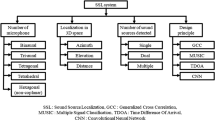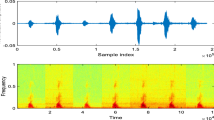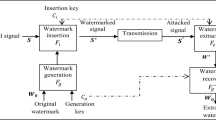Abstract
The quality of speech transmission in mobile communication systems deteriorates due to the presence of background noise and acoustic echo. The background noises are the disturbances from the surroundings and acoustic echo is induced due to the reverberation of loudspeaker signal in the near end environment. In conventional acoustic echo suppression setup, the echo path effect is modelled either in time or in frequency domain, and to cancel the echo, a replica of the echo is created by estimating the echo path response adaptively in the corresponding domain. Recently, the modulation domain analysis, which captures the human perceptual properties, is widely being used in speech processing. Modulation domain conveys the temporal variation of the acoustic magnitude spectra which acts as an information bearing signal. In this work, a novel integrated system for acoustic echo and noise suppression in the modulation domain is developed. So far, no work in this context in modulation domain has been found as reported. An efficient method for modelling the echo path and estimating the echo in the modulation domain is introduced and implemented. The effects of echo and noise are suppressed using the modulation spectral manipulation and the performance of the proposed system is found to be better than other conventional integrated systems.







Similar content being viewed by others
References
Atlas, L. (2003). Modulation spectral transform: Application to speech separation and modification. Technical Report 155, IEICE, Seattle, WA: University of Washington.
Avendano, C. (2001). Acoustic echo suppression in the STFT domain. In Applications of Signal Processing to Audio and Acoustics, 2001 IEEE Workshop on the, IEEE, pp. 175–178.
Bacon, S. P., & Grantham, D. W. (1989). Modulation masking: Effects of modulation frequency, depth, and phase. The Journal of the Acoustical Society of America, 85(6), 2575–2580.
Das, V., Kar, A., & Chandra, M. (2014). A new cross correlation based double talk detection algorithm for nonlinear acoustic echo cancellation. In TENCON 2014-2014 IEEE Region 10 Conference, IEEE, 2014, pp. 1–6.
Drullman, R., Festen, J. M., & Plomp, R. (1994a). Effect of reducing slow temporal modulations on speech reception. The Journal of the Acoustical Society of America, 95(5), 2670–2680.
Drullman, R., Festen, J. M., & Plomp, R. (1994b). Effect of temporal envelope smearing on speech reception. The Journal of the Acoustical Society of America, 95(2), 1053–1064.
Ephraim, Y., & Malah, D. (1984). Speech enhancement using a minimum-mean square error short-time spectral amplitude estimator. Acoustics, Speech and Signal Processing, IEEE Transactions on, 32(6), 1109–1121.
Faller, C., & Tournery, C. (2005). Estimating the delay and coloration effect of the acoustic echo path for low complexity echo suppression. In Proceeing od the Echo and Noise Control (IWAENC): Intl. Works. on Acoust.
Faller, C., & Tournery, C., (2006). Robust acoustic echo control using a simple echo path model. In Acoustics, Speech and Signal Processing, ICASSP 2006 Proceedings. 2006 IEEE International Conference on, Vol. 5, IEEE.
Gänsler, T., & Benesty, J. (2001). A frequency-domain double-talk detector based on a normalized cross-correlation vector. Signal Processing, 81(8), 1783–1787.
Gustafsson, S., Martin, R., & Vary, P. (1998). Combined acoustic echo control and noise reduction for hands-free telephony. Signal Processing, 64(1), 21–32.
Gustafsson, S., Martin, R., Jax, P., & Vary, P. (2002). A psychoacoustic approach to combined acoustic echo cancellation and noise reduction. Speech and Audio Processing, IEEE Transactions on, 10(5), 245–256.
Hermansky, H. (1998). Modulation spectrum in speech processing (pp. 395–406). (Boston, MA: Birkhäuser Boston. 978-1-4612-1768-8
Hsieh, H.-J., & Hung, J.-W. (2015). Magnitude replacement of real and imaginary modulation spectrum of acoustic spectrograms for noise-robust speech recognition. In Consumer Electronics-Taiwan (ICCE-TW), 2015 IEEE International Conference on, IEEE, pp. 328–329.
Hsieh, H.-J., Chen, B., & Hung, J.-W. (2015). Enhancing the complex-valued acoustic spectrograms in modulation domain for creating noise-robust features in speech recognition. In 2015 Asia-Pacific Signal and Information Processing Association Annual Summit and Conference (APSIPA), IEEE, pp. 303–307.
Hsu, C.-C., Cheong, K.-M., Chien, J.-T., & Chi, T.-S. (2015). Modulation Wiener filter for improving speech intelligibility. In 2015 IEEE International Conference on Acoustics, Speech and Signal Processing (ICASSP), IEEE, 2015, pp. 370– 374.
Hu, Y., & Loizou, P.C. (2006). Evaluation of objective measures for speech enhancement. In Proceding of the Interspeech Conference.
Loizou, P. (2007). Subjective evaluation and comparison of speech enhancement algorithms. Speech Communication, 49, 588–601.
Martin, R. (1994). Spectral subtraction based on minimum statistics. Proceeding of the EUSIPCO, power Vol. 6, p. 8.
Martin, R. (2001). Noise power spectral density estimation based on optimal smoothing and minimum statistics. Speech and Audio Processing, IEEE Transactions on, 9(5), 504–512.
McGovern, S. (2003). http://sgm-audio.com/research/rir/rir.html.
Ogunfunmi, T., Togneri, R., & Narasimha, M. (2015). Speech and audio processing for coding, enhancement and recognition. New York: Springer.
Paliwal, K., Schwerin, B., & Wójcicki, K. (2012). Speech enhancement using a minimum mean-square error short-time spectral modulation magnitude estimator. Speech Communication, 54(2), 282–305.
Park, Y.-S., & Chang, J.-H. (2009). Frequency domain acoustic echo suppression based on soft decision. Signal Processing Letters, IEEE, 16(1), 53–56.
Park, Y.-S., & Chang, J.-H. (2012). Integrated acoustic echo and background noise suppression technique based on soft decision. EURASIP Journal on Advances in Signal Processing, 2012(1), 1–9.
Varga, A., & Steeneken, H. J. (1993). Assessment for automatic speech recognition: II. NOISEX-92: A database and an experiment to study the effect of additive noise on speech recognition systems. Speech Communication, 12(3), 247–251.
Widrow, S. D. (1985). Stearns, adaptive signal processing (p. 491). Englewood Cliffs, NJ: Prentice-Hall, Inc.
Zadeh, L. A. (1950). Frequency analysis of variable networks. Proceedings of the IRE, 38(3), 291–299.
Author information
Authors and Affiliations
Corresponding author
Rights and permissions
About this article
Cite this article
Jayakumar, E.P., Shifas, P.V.M. & Sathidevi, P.S. Integrated acoustic echo and noise suppression in modulation domain. Int J Speech Technol 19, 611–621 (2016). https://doi.org/10.1007/s10772-016-9353-5
Received:
Accepted:
Published:
Issue Date:
DOI: https://doi.org/10.1007/s10772-016-9353-5




